Italian Armed Forces
| Italian Armed Forces Forze Armate Italiane | |
|---|---|
|
Coat of Arms of the Italian Defence Staff | |
| Founded | 4 May 1861 |
| Service branches |
Esercito Italiano (Army) Marina Militare (Navy) Aeronautica Militare (Air Force) Arma dei Carabinieri (Gendarmerie) |
| Headquarters | Rome |
| Leadership | |
| Commander-in-chief | Sergio Mattarella |
| Minister of Defence | Roberta Pinotti |
| Chief of the Defence Staff | Generale di Corpo d'Armata Claudio Graziano |
| Manpower | |
| Military age | 18 |
| Conscription | No. |
| Active personnel |
175,900 active (2014)[1] 103,893 Carabinieri (2014)[2] |
| Reserve personnel | 41,867 (2011) |
| Expenditures | |
| Budget | €20.670 billion (2014)[3](excl. MEF and MiSE funds) |
| Percent of GDP | 1.27% (2014)[4](excl. MEF and MSE funds) |
| Industry | |
| Domestic suppliers |
Avio Beretta Breda CNH Industrial Fincantieri Finmeccanica Fiocchi Munizioni Intermarine Piaggio Aerospace |
| Foreign suppliers |
|
| Annual imports | €2,202m (2011)[5] |
| Annual exports | €3,060m (2011)[5] |
| Related articles | |
| History |
Military history of Italy Regio Esercito Regia Marina Regia Aeronautica |
| Ranks |
Italian Army ranks Italian Navy ranks Italian Air Force ranks |
The Italian Armed Forces (italian: Forze Armate Italiane) encompass the Italian Army, the Italian Navy and the Italian Air Force. A fourth branch of the armed forces, known as the Carabinieri, take on the role as the nation's military and territorial police force. The President of the Italian Republic heads the armed forces as the President of the Supreme Council of Defence. As of 2014, the Italian military is the third largest of the European Union and the fifth among NATO nations with 175,900[1] personnel active in the army, navy and air force, plus 103,893[2] Carabinieri.
Italian Constitution
Article 11 of the Constitution of Italy reads:
Italy repudiates war as an instrument of aggression against the freedom of other peoples and as a means for the settlement of international disputes. Italy agrees, on conditions of equality with other States, to the limitations of sovereignty that may be necessary to a world order ensuring peace and justice among the Nations. Italy promotes and encourages international organisations furthering such ends.
Article 52 reads:
The defence of the country is a sacred duty for every citizen. Military service is obligatory within the limits and in the manner set by law. Its fulfilment shall not prejudice a citizen’s job, nor the exercise of political rights. The organisation of the armed forces shall be based on the democratic spirit of the Republic.
Article 78 reads:
The Parliament has the authority to declare a state of war and vest the necessary powers into the Government.
And part of article 87 reads:
The President [of the Republic] is the commander-in-chief of the armed forces, shall preside over the Supreme Council of Defence established by law, and shall make declarations of war as have been agreed by Parliament.
The four branches of Italian Armed Forces
Esercito Italiano
It is the Army (ground force) of the Italian Republic. The Army's history dates back to the unification of Italy in the 1850s and 1860s. It fought in colonial engagements in China, Libya (1911-1912), northern Italy against the Austro-Hungarian Empire during World War I, Abyssinia before World War II, and in World War II in Albania, Greece, north Africa, Russia and Italy itself. During the Cold War the Army prepared itself to defend against a Warsaw Pact invasion from the east. Since the end of the Cold War it has seen extensive peacekeeping service and combat in Afghanistan and Iraq. On July 29, 2004 it became a professional all-volunteer force when conscription was finally ended.
Aeronautica Militare
It is the air force of Italy, founded as an independent service arm on March 28, 1923, by King Vittorio Emanuele III as the Regia Aeronautica (which equates to "Royal Air Force"). After World War II, when Italy was made a republic by referendum, the Regia Aeronautica was given its current name.
Marina Militare
It is the Navy of Italy, created in 1946 as the Navy of the Italian Republic from the Regia Marina. In modern times, the Marina Militare, being a member of the North Atlantic Treaty Organisation (NATO), has taken part in many coalition peacekeeping operations. The Guardia Costiera is a component of the Marina Militare.
Carabinieri
It is the gendarmerie and military police of Italy. At the Sea Islands Conference of the G8 in 2004, the Carabinieri were given the mandate to establish a Center of Excellence for Stability Police Units (CoESPU) to spearhead the development of training and doctrinal standards for civilian police units attached to international peacekeeping missions.[6]
Missions and Operations
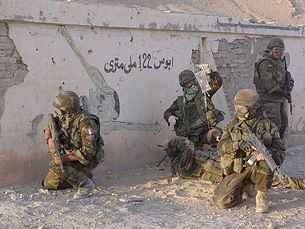
Italy has joined in many UN, NATO and EU operations as well as with assistance to Russia and the other CIS nations, Middle East peace process, multilateral talks, peacekeeping, and combating the illegal drug trade, human trafficking, piracy and terrorism.
Italy did take part in the 1982 Multinational Force in Lebanon along with US, French and British troops. Italy also participated in the 1990–91 Gulf War, but solely through the deployment of eight Panavia Tornado IDS bomber jets to Saudi Arabia; Italian Army troops were subsequently deployed to assist Kurdish refugees in northern Iraq following the conflict.
As part of Operation Enduring Freedom, Italy contributed to the international operation in Afghanistan. Italian forces have contributed to ISAF, the NATO force in Afghanistan, and to the Provincial reconstruction team. Italy has sent 411 troops, based on one infantry company from the 2nd Alpini Regiment tasked to protect the ISAF HQ, one engineer company, one NBC platoon, one logistic unit, as well as liaison and staff elements integrated into the operation chain of command. Italian forces also command a multinational engineer task force and have deployed a platoon of Carabinieri military police.
The Italian Army did not take part in combat operations of the 2003 Iraq War, dispatching troops only when major combat operations were declared over by the U.S. President George W. Bush. Subsequently Italian troops arrived in the late summer of 2003, and began patrolling Nasiriyah and the surrounding area. Italian participation in the military operations in Iraq was concluded by the end of 2006, with full withdrawal of Italian military personnel except for a small group of about 30 soldiers engaged in providing security for the Italian embassy in Baghdad, and about 87 soldiers stationing in bases in the Persian Gulf (but not in Iraqi territory). Italy played a major role in the 2004-2011 NATO Training Mission to assist in the development of Iraqi security forces training structures and institutions.
Operations
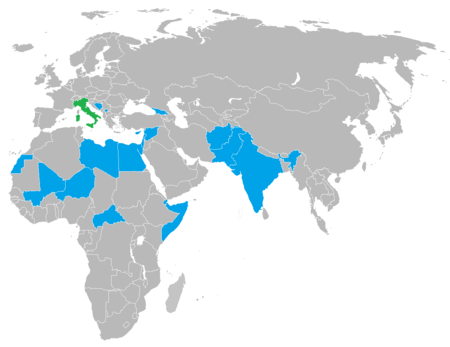
Since the second post-war the Italian armed force has become more and more engaged in international peace support operations, mainly under the auspices of the United Nations. The Italian armed forces are currently participating in 26 missions.[7]
Status of the Guardia di Finanza
The Guardia di Finanza military body does not fall within the Italian Armed Forces as it is fully subordinate to the Ministry of Economy and Finance and not to the Ministry of Defence. Even though it has a military status and does also participate to foreign missions it is simply a military body.
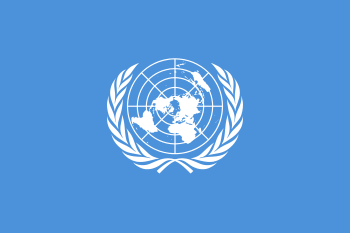 United Nations
United Nations
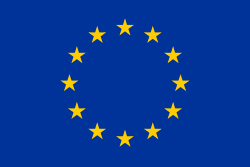 European Union
European Union
- EUFOR Althea, since 2004 (Bosnia and Herzegovina)
- EUBAM Rafah, since 2005 (Gaza–Egypt border)
- EUPOL Afghanistan, since 2007 (Afghanistan)
- EUNAVFOR Atalanta, since 2008 (Gulf of Aden)
- EUMM Georgia, since 2008 (Georgia, South Ossetia and Abkhazia)
- EULEX Kosovo, since 2008 (Kosovo)
- EUTM Somalia, since 2010 (Somalia)
- EUCAP Nestor, since 2012 (Indian Ocean)
- EUCAP Sahel Niger, since 2012 (Niger)
- EUBAM Libya, since 2013 (Libya)
- EUTM Mali, since 2013 (Mali)
- EUFOR RCA, since 2014 (Central African Republic)
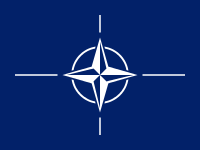 NATO
NATO
- KFOR, since 1999 (Kosovo)
- ISAF, since 2001 (Afghanistan)
- Operation Active Endeavour, since 2001 (Mediterranean Sea and the Strait of Gibraltar)
- Operation Ocean Shield, since 2009 (Gulf of Aden)
- Multilateral missions
References
- ↑ 1.0 1.1 "Documento Programmatico Pluriennale per la Difesa per il triennio 2014-16" (PDF) (in Italian). Italian Ministry of Defence. 13 June 2014. p. 141. Retrieved 8 January 2015. features include only Army, Navy and Air Force
- ↑ 2.0 2.1 "Documento Programmatico Pluriennale per la Difesa per il triennio 2014-16" (PDF) (in Italian). Italian Ministry of Defence. 13 June 2014. p. 198. Retrieved 8 January 2015.
- ↑ "Attribuzione e Ripartizione degli stanziamenti" (PDF) (in Italian). Italian Ministry of Defence. 13 June 2014. p. 2. Retrieved 8 January 2015.
- ↑ "Documento Programmatico Pluriennale per la Difesa per il triennio 2014-16" (PDF) (in Italian). Italian Ministry of Defence. 13 June 2014. p. 72. Retrieved 8 January 2015.
- ↑ 5.0 5.1 "RAPPORTO del PRESIDENTE DEL CONSIGLIO DEI MINISTRI sui lineamenti di politica del Governo in materia di esportazione, importazione e transito dei materiali d’armamento" (PDF) (in Italian). Ufficio del Consigliere Militare Servizio di Coordinamento della Produzione di Materiali di Armamento. 23 April 2012. p. 25. Retrieved 2015-01-04.
- ↑ G-8 Action Plan: Expanding global capability for peace support operations. Carabinieri, June 2004.
- ↑ (Italian) Documento programmatico pluriennale per la Difesa per il triennio 2014-2016. Italian Ministry of Defence, August 2014.
External links
- (Italian) Official Site of Italian Ministry of Defense
- (Italian) Official Site of Italian Army
- (Italian) Official Site of Italian Navy
- (Italian) Official Site of Italian Air Force
- (Italian) Official Site of Carabinieri
| ||||||
| ||||||||||||||||||||||||||||||||||||||||||||
| ||||||||||||||||||||
| ||||||
| ||||||||||||||
